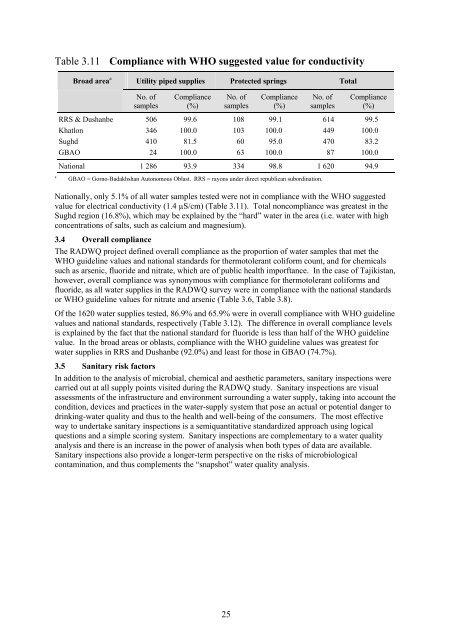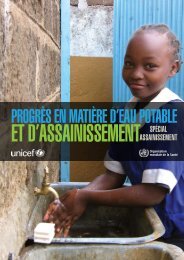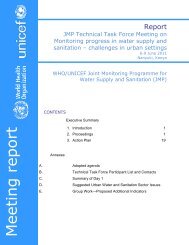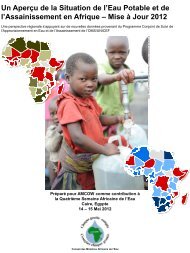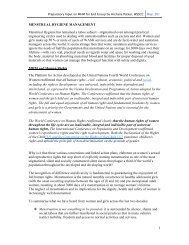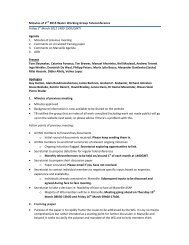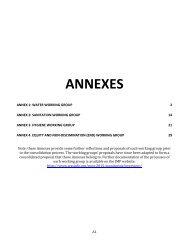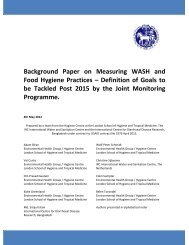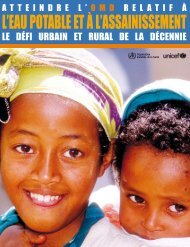rapid assessment of drinking-water quality in the republic of tajikistan
rapid assessment of drinking-water quality in the republic of tajikistan
rapid assessment of drinking-water quality in the republic of tajikistan
You also want an ePaper? Increase the reach of your titles
YUMPU automatically turns print PDFs into web optimized ePapers that Google loves.
Table 3.11 Compliance with WHO suggested value for conductivity<br />
a<br />
Broad area a Utility piped supplies Protected spr<strong>in</strong>gs Total<br />
No. <strong>of</strong><br />
samples<br />
Compliance<br />
(%)<br />
No. <strong>of</strong><br />
samples<br />
Compliance<br />
(%)<br />
No. <strong>of</strong><br />
samples<br />
Compliance<br />
(%)<br />
RRS & Dushanbe 506 99.6 108 99.1 614 99.5<br />
Khatlon 346 100.0 103 100.0 449 100.0<br />
Sughd 410 81.5 60 95.0 470 83.2<br />
GBAO 24 100.0 63 100.0 87 100.0<br />
National 1 286 93.9 334 98.8 1 620 94.9<br />
GBAO = Gorno-Badakhshan Autonomous Oblast. RRS = rayons under direct <strong>republic</strong>an subord<strong>in</strong>ation.<br />
Nationally, only 5.1% <strong>of</strong> all <strong>water</strong> samples tested were not <strong>in</strong> compliance with <strong>the</strong> WHO suggested<br />
value for electrical conductivity (1.4 µS/cm) (Table 3.11). Total noncompliance was greatest <strong>in</strong> <strong>the</strong><br />
Sughd region (16.8%), which may be expla<strong>in</strong>ed by <strong>the</strong> “hard” <strong>water</strong> <strong>in</strong> <strong>the</strong> area (i.e. <strong>water</strong> with high<br />
concentrations <strong>of</strong> salts, such as calcium and magnesium).<br />
3.4 Overall compliance<br />
The RADWQ project def<strong>in</strong>ed overall compliance as <strong>the</strong> proportion <strong>of</strong> <strong>water</strong> samples that met <strong>the</strong><br />
WHO guidel<strong>in</strong>e values and national standards for <strong>the</strong>rmotolerant coliform count, and for chemicals<br />
such as arsenic, fluoride and nitrate, which are <strong>of</strong> public health imporftance. In <strong>the</strong> case <strong>of</strong> Tajikistan,<br />
however, overall compliance was synonymous with compliance for <strong>the</strong>rmotolerant coliforms and<br />
fluoride, as all <strong>water</strong> supplies <strong>in</strong> <strong>the</strong> RADWQ survey were <strong>in</strong> compliance with <strong>the</strong> national standards<br />
or WHO guidel<strong>in</strong>e values for nitrate and arsenic (Table 3.6, Table 3.8).<br />
Of <strong>the</strong> 1620 <strong>water</strong> supplies tested, 86.9% and 65.9% were <strong>in</strong> overall compliance with WHO guidel<strong>in</strong>e<br />
values and national standards, respectively (Table 3.12). The difference <strong>in</strong> overall compliance levels<br />
is expla<strong>in</strong>ed by <strong>the</strong> fact that <strong>the</strong> national standard for fluoride is less than half <strong>of</strong> <strong>the</strong> WHO guidel<strong>in</strong>e<br />
value. In <strong>the</strong> broad areas or oblasts, compliance with <strong>the</strong> WHO guidel<strong>in</strong>e values was greatest for<br />
<strong>water</strong> supplies <strong>in</strong> RRS and Dushanbe (92.0%) and least for those <strong>in</strong> GBAO (74.7%).<br />
3.5 Sanitary risk factors<br />
In addition to <strong>the</strong> analysis <strong>of</strong> microbial, chemical and aes<strong>the</strong>tic parameters, sanitary <strong>in</strong>spections were<br />
carried out at all supply po<strong>in</strong>ts visited dur<strong>in</strong>g <strong>the</strong> RADWQ study. Sanitary <strong>in</strong>spections are visual<br />
<strong>assessment</strong>s <strong>of</strong> <strong>the</strong> <strong>in</strong>frastructure and environment surround<strong>in</strong>g a <strong>water</strong> supply, tak<strong>in</strong>g <strong>in</strong>to account <strong>the</strong><br />
condition, devices and practices <strong>in</strong> <strong>the</strong> <strong>water</strong>-supply system that pose an actual or potential danger to<br />
<strong>dr<strong>in</strong>k<strong>in</strong>g</strong>-<strong>water</strong> <strong>quality</strong> and thus to <strong>the</strong> health and well-be<strong>in</strong>g <strong>of</strong> <strong>the</strong> consumers. The most effective<br />
way to undertake sanitary <strong>in</strong>spections is a semiquantitative standardized approach us<strong>in</strong>g logical<br />
questions and a simple scor<strong>in</strong>g system. Sanitary <strong>in</strong>spections are complementary to a <strong>water</strong> <strong>quality</strong><br />
analysis and <strong>the</strong>re is an <strong>in</strong>crease <strong>in</strong> <strong>the</strong> power <strong>of</strong> analysis when both types <strong>of</strong> data are available.<br />
Sanitary <strong>in</strong>spections also provide a longer-term perspective on <strong>the</strong> risks <strong>of</strong> microbiological<br />
contam<strong>in</strong>ation, and thus complements <strong>the</strong> “snapshot” <strong>water</strong> <strong>quality</strong> analysis.<br />
25


